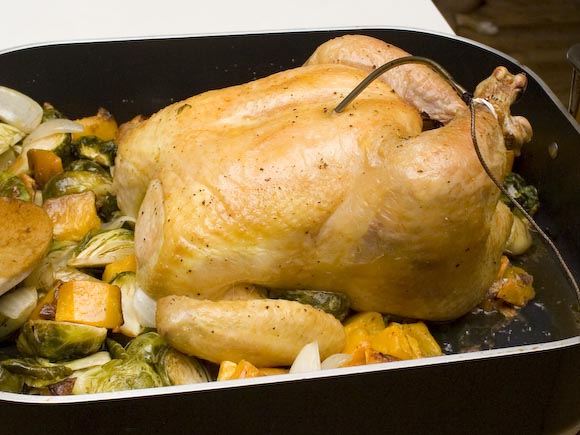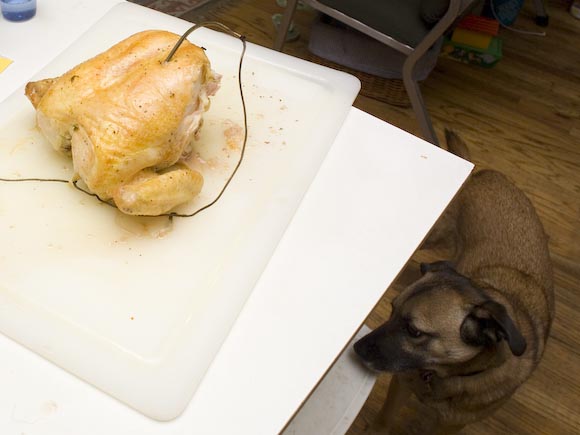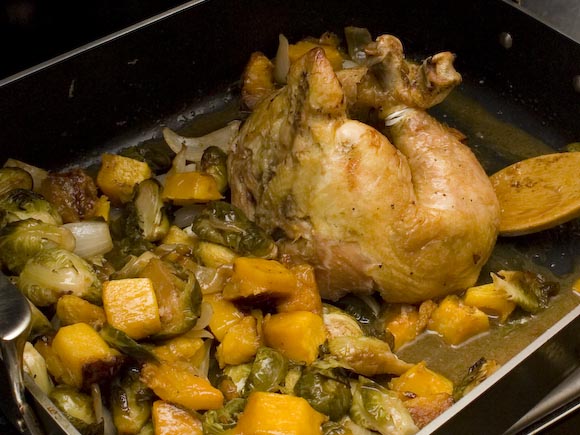Roast chicken (and to a lesser extent, turkey) was my white whale for a few years. Since white meat is done at 160 degrees and dark meat at 175, you’re left with a dilemma. Cook the white meat just right and the dark is inedible, make the dark safe for eating and the white is dry and stringy. After many experiments I’ve arrived at a technique that yields perfect white and dark meat. At this point I’d like to say that the closest I’ve come to mouth kissing a man was when my brother in law called my Thanksgiving turkey ‘succulent’.
But first, some chi chi
Have you ever wondered why chickens and turkeys have white breast meat while ducks have dark breast meat? No? Why not, it’s really interestinzzzzz…
See, chickens and turkeys can’t fly, and they use their wings for rapid bursts to escape. Since they only flap their wings for seconds at a time, their breasts have more fast twitch muscles. And since fast twitch muscles rely on glycogen instead of oxygen (which is delivered by blood), they’re less vascularized and lighter in color. Ducks, on the other hand, can fly all day, so they have darker slow twitch breast meat.
So what does this have to do with cycling? Well, even though Schmalz is very pasty on the outside, he’s actually mostly dark meat. Why? Because he can’t sprint his way out of a paper bag! Pow! Zing! 200 words to get to that! Thank you, I’ll be here all week.

And now back to our regularly scheduled dumbassing
Roast chicken might seem like a difficult dish, but it’s actually not labor intensive. It takes a lot of time, but very little work is involved. And now that my family is treating meat as a side dish instead of the main course, one chicken will last the three of us a whole week – dinner the first night, wraps and sandwiches for lunch the rest of the week. Stock is made from the bones, so we get a ton of good eatin’ from one nine dollar chicken.
Start by brining the chicken. There’s plenty of brine recipes out there, but the only key ingredient is the salt. The salinity of the brine makes the meat moist – especially critical for white meat. I’ll usually start the day by dissolving on the stove about a 1/2 cup of salt in a stock pot filled about a quarter of the way. You can add other ingredients now as well, like bay leaves, sugar, cloves, cinnamon, etc., but to be honest, I’ve never really been able to taste these additions. For me, brine improves the texture of the meat, not the flavor. Once the salt is dissolved, cool the brine with cold water and ice cubes, and refrigerate. The chicken goes in once the brine is cold enough to not be a cesspool of samonella. A five to seven hour soak should do. Don’t overdo this or you’ll get an incredibly salty chicken. Turkeys can go overnight.
Once the brining is done, rinse off the bird, pat dry, and salt and pepper liberally inside and out. Stuff the cavity with a halved lemon and a handful of tarragon. Tie the bird off, rub with vegetable oil (not olive oil). Stick a probe thermometer in the breast (don’t even try this without one of these), making sure it doesn’t touch the bone, and you’re ready to go. You can use a rack in a roasting pan, but they’re a nuisance to clean and they tear the skin. My preferred method is to set the chicken breast side up on a bed of quartered new potatoes or cubed butternut squash. They’re the ultimate non stick surface, and they’re delicious roasted with the chicken juices. Just season the veggies and toss in a bit of vegetable oil.
Start the chicken at 450 to get a sear, turn the oven down to 350 after fifteen minutes. Don’t open the oven ’til the probe reads 158 – no basting! If you want to add brussels sprouts or vidalia onions to the veggies, do so at about 90 degrees. Take the chicken out at 158, draining as much juice from the cavity as possible. Cut along the thigh/breast line, bend the spine back and sever it. Return the dark meat and the vegetables to the oven for another 15-20 minutes (20-25 for turkey). By then the white meat will be well rested and ready to carve, and you’ll have a full meal in one roasting pan. If you’re trying to impress someone put the vegetables in the center of a platter and surround with the chicken.

 The white meat rests under Ginger’s watchful eye while the dark meat returns to the oven.

If you’re cooking a turkey you’ll get a beautiful brown bird. However, chicken just doesn’t cook long enough to look that good, unless you’re a food stylist. If you must have beautiful crispy skin, you can coat it with something sugary so that it’ll caramelize. Dilute some orange marmalade with orange juice, reduce with some julienned lemon zest, and brush over your bird when it hits 120 degrees or so.

actually, they eat more dog in Vietnam than Korea.
now if we were in Korea the dog would in the pan the chicken would be walking around.. How much for dog? make good soup.
Wow! Anonymous bigoted stereotypes! A first!
wha? this is actually about chicken?!?
nice.
I can’t believe you’d do that to a chicken. Just terrible.
Chicken costs nine dollars?
Dry the skin thoroughly before cooking and then coat with oil (or perhaps butter)
halfway through cooking will crisp up the skin on the bottom, baste the white meat with the dark meat deliciousness and even out the cooking of the dark and white meat.
That dish is photo-shopped. After the wind tunnel, I don’t believe you any more.
The Schmaltz stab…Priceless